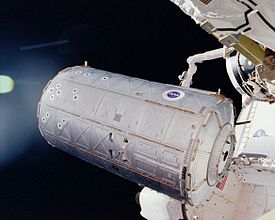Destiny (ISS module)
| Destiny | ||||||||||||||||||||||
|---|---|---|---|---|---|---|---|---|---|---|---|---|---|---|---|---|---|---|---|---|---|---|
 Destiny module during installation
|
||||||||||||||||||||||
| Space station: | International space station | |||||||||||||||||||||
| Start date: | February 7, 2001 | |||||||||||||||||||||
| Launcher: | Space Shuttle Atlantis | |||||||||||||||||||||
| Coupling: | February 10, 2001 | |||||||||||||||||||||
| Dimensions: | 14.5 t | |||||||||||||||||||||
| Length: | 8.5 m | |||||||||||||||||||||
| Diameter: | 4.3 m | |||||||||||||||||||||
| Adjacent modules | ||||||||||||||||||||||
|
||||||||||||||||||||||
Destiny ( English for fate ) is the fourth module of the International Space Station and the second from the USA . It has a cylindrical shape, is 8.5 m long, has a diameter of 4.3 m and a curb weight of 14.5 t. Fully equipped, its mass is 24.0 t.
At the stern, Destiny is permanently connected to the Unity coupling module and at the bow to the Harmony connection node . Destiny was launched on February 7, 2001 with the STS-98 mission.
A total of 24 standard racks are available: 13 of them can be used for experiments and scientific equipment, while the remaining 11 can be used for control or as storage space.
The shell of the laboratory module is made of aluminum and is also surrounded by a micrometeorite protection. This consists of a material that is similar to the bulletproof vest. Destiny has a large window that can be closed with a kind of shutter. Above all, earth-related research should be carried out via this window.
Four racks were installed at the start. They are primarily used to control the most important systems and to support life. It includes systems for air ventilation, two water-based cooling systems (4 ° C and 17 ° C system), two so-called avionics racks with control systems for internal communication, for position control, life support, environmental data, coupling mechanisms, pressure compensation , command and data processing as well as the energy and alarm systems (fire detection and air pressure control). A fifth rack with an air handling system was also installed.
Further supply racks (service water systems, support for spacecraft work, track tracking and communication) and research equipment were later installed. There were also three rows free for six racks each. All racks are provided with power and control systems via a central energy and data bus. There are also two universal cooling systems available. At times, samples from experiments that have already been completed can also be stored under special conditions (e.g. frozen). The racks are universal, standardized and interchangeable. The transport takes place within special logistics modules ( MPLM ).
In the US laboratory module Destiny, experiments in the fields of microgravity , life sciences, biology, ecology, earth exploration, space research and technology are carried out. Commercial research is also planned.
Leroy Chiao in the Destiny module
Kevin Ford pilot of STS-128 in the Destiny lab
Serena Auñón-Chancellor doing maintenance




